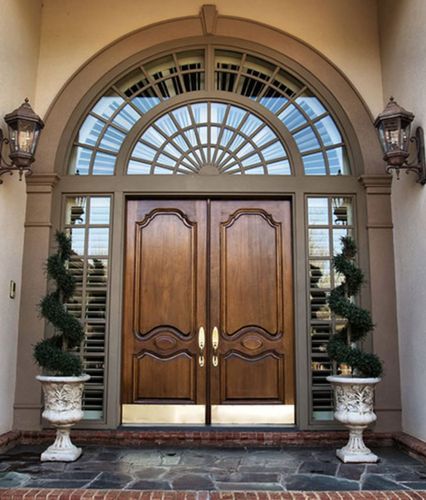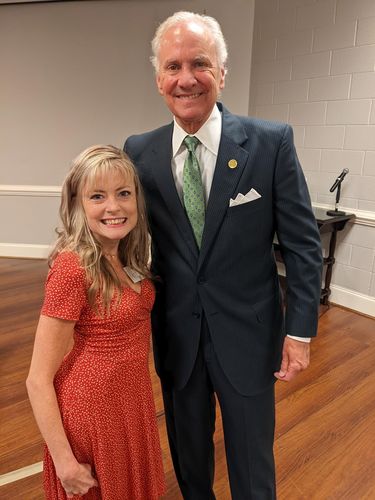26 Dec October 2022: Your Front Door Should Reflect Your Tastes

|
Kandy and I had the opportunity to meet and speak with South Carolina Governor Henry McMaster at an event this past week. |
Jessy, our youngest, was with us when we chatted with Governor McMaster. She does book work for Willis Sinclair, works at Twig (a boutique she and Mandy own) and helps a local man with his political campaign. |

From the Desk of Mandy
“Those who prepare to survive deserve to survive”.
For as long as I can remember, my parents have had an embroidered version of this saying hanging on the wall.
I find it fascinating now, just as I did when I was a child.
Seeing it would make me think about preparation and survival, and the way they relate to each other. I would also ponder the opposite: “Those who do not prepare to survive do not deserve to survive.” (Now there’s a thought-stimulating sentiment — and very relevant to me as a middle-school student that had failed to study for a history test.)
The saying always makes me think of preppers, in general. “Preppers” is a term used to describe the people who stockpile supplies (often food, currency, or … toilet paper) so they can comfortably ride out a certain amount of time (during natural disasters or civic unrest) when the basics aren’t readily accessible. It seems that every disaster highlights two groups of people: the preppers and the looters. The preppers prudently put aside some necessities ahead of time; the looters sift through the aftermath of a disaster to see what they can get out of it.
In my opinion, preparedness goes hand-in-hand with maturity. Conversely, unpreparedness seems to go hand-in-hand with an entitlement mentality.
Preparedness shouldn’t be limited to long-term food storage; being prepared is an essential (though fast-fading) part of being an adult. Whether we’re pondering questions of eternity or simply considering how soon to start studying for that upcoming history test, it’s always better to be prepared.
Those who prepare to survive do indeed deserve to survive.
Front doors
On many homes, the exterior doors are similar except for the front door. Some of the exterior doors may be solid, some may have windows (lights) and some may be French (large glass center), but generally they are similar. The front door is a special door that sets the tone for the house.
The front door is unique among the exterior doors. The options for the front entry door are nearly endless. Most exterior doors are 36 inches wide, but it is not uncommon for a front door to be 42 or even 48 inches wide.
 There are a number of terms associated with exterior doors including front doors. Since this is a single door, there is not an astragal (the vertical board between two doors) shown. The sidelights can be partial glass as shown, full glass or no glass.
There are a number of terms associated with exterior doors including front doors. Since this is a single door, there is not an astragal (the vertical board between two doors) shown. The sidelights can be partial glass as shown, full glass or no glass.
Normally, front doors swing in although Florida requires them to swing out because of high wind threats. An inswinging door has only the hinges and latch to prevent them from opening in a strong wind. An outswing door has the door stop (the wood around the door that holds the seal. Here in South Carolina, we see both inswing and outswing exterior doors. Somehow, it seems more inviting to me to have an inswing door to invite people into your home.
A three point latch is a good way to make an inswing door close solidly. A three point latch has a latch like a normal door and it has two more latches (hence the “three point” name): one that goes up into the head
and one that goes down into the sill or floor. The three point latch (roughly) triples the force needed to force the door open.
 Although a door like this would look out of place on a main house, it would look cozy on a cottage or guest house. Notice there are also shutters to match the round top door.
Although a door like this would look out of place on a main house, it would look cozy on a cottage or guest house. Notice there are also shutters to match the round top door.
Front doors can be a single door or double door. Double doors usually have an astragal to insure they seal tightly.
In addition to the number of doors, a front door may have a transom (window over the door) although transoms are not unique to front doors.  This over the top entry has double doors, two full glass sidelights and an arched transom. The doors are mahogany panel doors with brass kick plates.
This over the top entry has double doors, two full glass sidelights and an arched transom. The doors are mahogany panel doors with brass kick plates.
Exterior doors are typically 1¾ inches thick. Another common thickness for doors is 2¼ inches. These doors are heavy and have a solid feel. The material used in the door is also a variable. There are seemingly endless choices.
The shape of the doors is also a variable. Most are rectangles although some have semicircular tops.
If you have an existing home (and not currently building a new home), you can refresh your front door sometimes with stain, paint or perhaps added trim. The front door assembly can even be replaced as long as the new door assembly and the existing assembly are roughly the same size and shape. Keep in mind any color changes will probably need approval from the ARB.
If you have questions, call or text us (843 846 2500) or email us (info@willissinclair.com. We will be glad to discuss options with you. No cost or obligation on your part, of course.
Next month we will discuss troubleshooting techniques.







No Comments